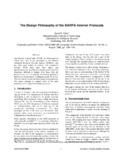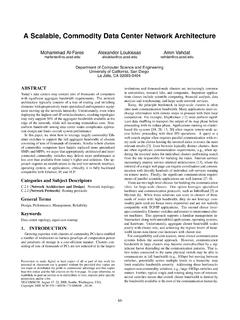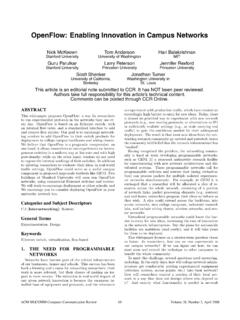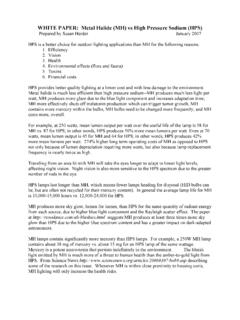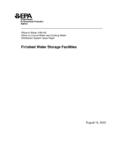Transcription of How to Read a Paper - SIGCOMM
1 How to read a PaperS. KeshavDavid R. Cheriton School of Computer Science, University ofWaterlooWaterloo, ON, spend a great deal of time reading research pa-pers. However, this skill is rarely taught, leading to muchwasted effort. This article outlines a practical and efficientthree-pass methodfor reading research papers. I also de-scribe how to use this method to do a literature and Subject [Introductoryand Survey]General : Paper , Reading, must read papers for several reasons: to re-view them for a conference or a class, to keep current intheir field, or for a literature survey of a new field. A typi-cal researcher will likely spend hundreds of hours every yearreading to efficiently read a Paper is a critical but rarelytaught skill.
2 Beginning graduate students, therefore, mustlearn on their own using trial and error. Students wastemuch effort in the process and are frequently driven to many years I have used a simple approach to efficientlyread papers. This Paper describes the three-pass approachand its use in doing a literature THREE-PASS APPROACHThe key idea is that you should read the Paper in up tothree passes, instead of starting at the beginning and plow-ing your way to the end. Each pass accomplishes specificgoals and builds upon the previous pass: Thefirstpassgives you a general idea about the Paper . Thesecondpasslets you grasp the Paper s content, but not its details.
3 Thethirdpass helps you understand the Paper in The first passThe first pass is a quick scan to get a bird s-eye view ofthe Paper . You can also decide whether you need to do anymore passes. This pass should take about five to ten minutesand consists of the following steps:1. Carefully read the title, abstract, and introduction2. read the section and sub-section headings, but ignoreeverything else3. read the conclusions4. Glance over the references, mentally ticking off theones you ve already readAt the end of the first pass, you should be able to answerthefive : What type of Paper is this? A measure-ment Paper ? An analysis of an existing system?
4 Adescription of a research prototype? : Which other papers is it related to? Whichtheoretical bases were used to analyze the problem? : Do the assumptions appear to be valid? : What are the Paper s main contribu-tions? : Is the Paper well written?Using this information, you may choose not to read fur-ther. This could be because the Paper doesn t interest you,or you don t know enough about the area to understand thepaper, or that the authors make invalid assumptions. Thefirst pass is adequate for papers that aren t in your researcharea, but may someday prove , when you write a Paper , you can expect mostreviewers (and readers) to make only one pass over it.
5 Takecare to choose coherent section and sub-section titles andto write concise and comprehensive abstracts. If a reviewercannot understand the gist after one pass, the Paper willlikely be rejected; if a reader cannot understand the high-lights of the Paper after five minutes, the Paper will likelynever be The second passIn the second pass, read the Paper with greater care, butignore details such as proofs. It helps to jot down the keypoints, or to make comments in the margins, as you Look carefully at the figures, diagrams and other illus-trations in the Paper . Pay special attention to the axes properly labeled? Are results shown witherror bars, so that conclusions are statistically sig-nificant?
6 Common mistakes like these will separaterushed, shoddy work from the truly Remember to mark relevant unread references for fur-ther reading (this is a good way to learn more aboutthe background of the Paper ).ACM SIGCOMM Computer Communication Review83 Volume 37, Number 3, July 2007 The second pass should take up to an hour. After thispass, you should be able to grasp the content of the should be able to summarize the main thrust of the pa-per, with supporting evidence, to someone else. This level ofdetail is appropriate for a Paper in which you are interested,but does not lie in your research you won t understand a Paper even at the endof the second pass.
7 This may be because the subject matteris new to you, with unfamiliar terminology and the authors may use a proof or experimental techniquethat you don t understand, so that the bulk of the pa-per is incomprehensible. The Paper may be poorly writtenwith unsubstantiated assertions and numerous forward ref-erences. Or it could just be that it s late at night and you retired. You can now choose to: (a) set the Paper aside, hopingyou don t need to understand the material to be successfulin your career, (b) return to the Paper later, perhaps afterreading background material or (c) persevere and go on tothe third The third passTo fully understand a Paper , particularly if you are re-viewer, requires a third pass.
8 The key to the third passis to attempt tovirtually re-implementthe Paper : that is,making the same assumptions as the authors, re-create thework. By comparing this re-creation with the actual Paper ,you can easily identify not only a Paper s innovations, butalso its hidden failings and pass requires great attention to detail. You shouldidentify and challenge every assumption in every , you should think about how you yourself wouldpresent a particular idea. This comparison of the actualwith the virtual lends a sharp insight into the proof andpresentation techniques in the Paper and you can very likelyadd this to your repertoire of tools.
9 During this pass, youshould also jot down ideas for future pass can take about four or five hours for beginners,and about an hour for an experienced reader. At the endof this pass, you should be able to reconstruct the entirestructure of the Paper from memory, as well as be able toidentify its strong and weak points. In particular, you shouldbe able to pinpoint implicit assumptions, missing citationsto relevant work, and potential issues with experimental oranalytical A LITERATURE SURVEYP aper reading skills are put to the test in doing a literaturesurvey. This will require you to read tens of papers, perhapsin an unfamiliar field.
10 What papers should you read ? Hereis how you can use the three-pass approach to , use an academic search engine such as Google Scholaror CiteSeer and some well-chosen keywords to find three tofiverecentpapers in the area. Do one pass on each pa-per to get a sense of the work, then read their related worksections. You will find a thumbnail summary of the recentwork, and perhaps, if you are lucky, a pointer to a recentsurvey Paper . If you can find such a survey, you are the survey, congratulating yourself on your good , in the second step, find shared citations andrepeated author names in the bibliography. These are thekey papers and researchers in that area.
